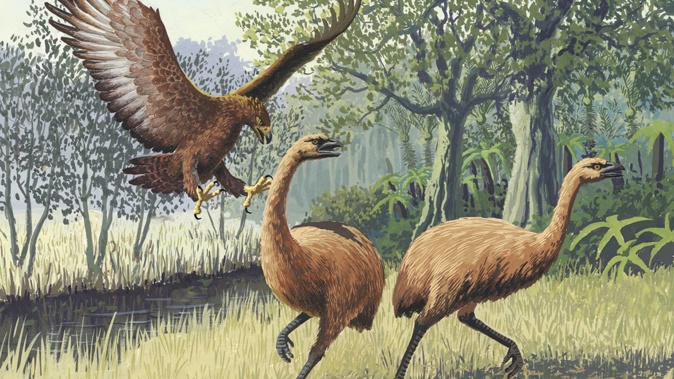
New Zealand's long-lost moa can offer useful insights into how today's species might respond to a fast-changing climate, scientists say.
In a just-published study, Otago University researchers simultaneously analysed millions of pieces of DNA from moa fossils, to explore how moa changed their distribution as the climate heated and cooled.
They found that during the last ice age 25,000 years ago, the eastern moa – a sub-species once spread across the eastern and southern South Island - retreated to the south, leading to lower genetic diversity than other species who inhabited more areas.
The heavy-footed moa, meanwhile, headed to both southern and northern regions of the South Island, while the upland moa inhabited four different areas.
Lead author Dr Alex Verry said the species was spread across the eastern and southern South Island during the warmer Holocene period, but was restricted to the southern South Island during the height of the last Ice Age about 25,000 years ago.
This is in comparison to the heavy-footed moa, which retreated to both southern and northern regions of the South Island, while the upland moa inhabited four different areas.
"The eastern moa's response had consequences for its population size and genetic diversity – the last Ice Age lead to a pronounced genetic bottleneck which meant it ended up with lower genetic diversity than other moa living in the same areas," Verry said.
The study, published in Biology Letters, marked the first time that high-throughput DNA sequencing, which simultaneously sequences millions of pieces of DNA, has been used to investigate moa at the population level.
The findings highlighted how past climate change impacted species in different ways and that a "one size fits all" model was not practical.
"It makes us wonder what is going to happen to species as they attempt to adapt to climate change today and into the future?" Verry said.
"Will they also attempt to move to new areas in order to survive? For some species this will not be possible, some species will run out of space, such as alpine species which will have to move upward but can only go so far until there is no more 'up'."
Co-author Dr Nic Rawlence, director of Otago's Palaeogenetics Laboratory, said the research was a rare example of the impacts of past climate change on extinct megafauna from New Zealand.
"It showed that we had all of these individualistic responses to climate change – and that you can't put everything in the same basket.
"So, in terms of future species, we're actually going to need conservation management tailed to individual species – and ensuring that they have habitat available so that they can respond."
Evidence gathered from sediment and ice suggests it's been about 10,000 years since the average annual temperature was as high as it is today - and temperatures we're now feeling are therefore likely to be near the top of the range that current ecosystems have experienced.
That's already limiting where our species can live.
Early signs include two weta species moving to higher elevations on Mt Taranaki, while native birds have retreated into cooler parts of their former habitats because there are more predators like possums, rats, and stoats in warmer lowland forests.
As the area of cooler forests shrinks, that pressure from predators will increase further - especially on large birds like kiwi, whio and North Island kokako that can't easily move.
Rawlence said the study also demonstrated how fossil remains and museum collections could be used to answer new questions about the past.
"This is really bringing the power of palaeogenomics to New Zealand research questions, whereas previously most research and interest has focused on Eurasian or American species.
"We are really starting to build capacity for this research in New Zealand."
Take your Radio, Podcasts and Music with you









